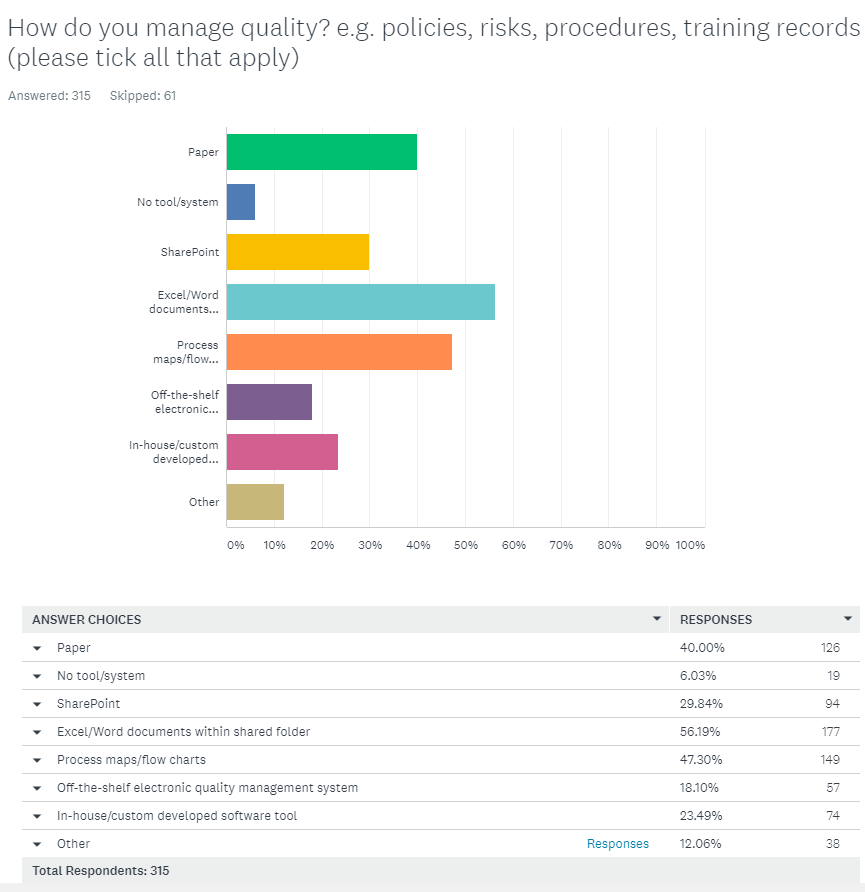Want to contribute to this article?
Quality management software puts an end to many day-to-day frustrations - from assigning roles and responsibilities, to ensuring the latest SOPs are used, managing audit programs to ensuring a risk based approach, and so on...
But once you've made the decision that you need a quality management software tool, you may need to decide whether it's best for your business to buy the tool off-the-shelf or develop your own in-house system.
To help you to make the right decision for you, your career and your business, we recommend building a scorecard to objectively assess both options.
Read on below for 16 criteria to add to your scorecard and a template you can download.
.png?width=357&name=Put%20your%20development%20skills%20to%20use%20in%20building%20what%20truly%20differentiates%20your%20business.%20Buy%20software%20for%20the%20commodity%20functions%20that%20every%20business%20needs.%20(1).png)
Select the criteria for your scorecard
You should assess your internal teams as you would a third-party supplier.
Here are 16 criteria - choose just 8 - 10 of the below which are the most relevant to you and then rank them each out of ten .
Criteria |
Considerations when ranking them |
| 1. Four-year total cost of ownership |
Businesses rarely develop their own customer relationship management, finance system, or email tool. They buy it because economies of scale means you can have a tool which would cost your business millions of pounds to develop for a fraction of the cost. Erik Dietrich said: "You should put your development skills to use in building what truly differentiates your business. Buy software for the commodity functions that every business needs." Most organisations decide the quality management system which works for hundreds of other businesses across multiple verticals will work for their business. When assessing and comparing costs, it's important to ensure you include everything from hosting to training, system maintenance to cost of external parties you may need to hire to complete unforeseen complexities in the project. Calculate four-year total cost of ownership here: quality.eqms.co.uk/eqms-buying-toolkit |
| 2. Return on investment |
Many businesses start using the tool for document control and auditing, then add risks and issues, then training records and suppliers, then equipment and assets. Eventually, all processes are managed in a single source of truth. With your in-house software system, will you be able to mature, grow and expand as rapidly? Or would a configurable off-the-shelf system provide more opportunity for your business? Consider and compare the four-year return on investment of both systems. |
|
3. Managing change |
Perhaps you've already got an in-house superstar development team who have already been employed by the company - so the costs are covered. But will you need experts to map out the user cases? What happens if a member of the team leaves the company? What will the system cost to maintain? No matter how familiar or well-coded a system, it will always take some time for a new developer to fix or add new code to a custom built tool. Does your business have processes to manage these changes? With a third-party supplier, this is unlikely to be an issue for you. |
| 4. Custom process |
One of the most common reasons for considering building a system in-house is that the features and functionality you need simply aren't currently available. But that doesn't mean building your own tool from scratch is your only option. 30% of Qualsys customers request a bespoke feature, tool or integration If there is a unique feature you need which is not currently available off-the-shelf, some quality management software providers, such as Qualsys, will offer a custom development service. This will likely be more cost effective than building an entire system from scratch. Furthermore, outsourcing skilled development work mitigates your risk of project failure and means you don't need to hire additional internal project managers, developers and quality consultants. |
| 5. Time to build |
An analysis of 5,400 IT projects found the average enterprise software project overran by 33%. Furthermore, 56 percent of IT projects deliver less value than predicted. Does this supplier or your internal team have a reputation for delivering projects on-time and on-budget? With the customer-supplier relationship, you may have a lot more leverage than you would with an internal team. Qualsys provides off-the-shelf quality management software which can be configured to meet your own processes. Configuration, training and full data migration are usually complete in EQMS within two months. |
| 6. Time to scope |
Whether you buy off-the-shelf or are planning to build in-house, it's going to take some time to get your team together and learn what you all want from the system. If it takes months to just get your management team together, how long will it take to fully scope an in-house developed tool? When developing in-house, remember you need to consider:
|
| 7. Company culture |
If your IT team have three software systems to manage, where will yours sit in their list of priorities? For many businesses, it's going to be in the middle to bottom of their priorities. Customer-facing software and applications are going to be at the top of their priorities. So how long will it take if there is an issue which needs to be resolved? How long will this project stay in the IT team's top priorities before there is a new project? |
| 8. Project management |
Whether you're planning to hire an external contractor to project manage the quality management software build or do-it-yourself, this all has a cost and risk associated with it. With your in-house developed system, you need a project manager who has experience implementing management systems, knowledge of frameworks, and has a solid understanding of quality best practices.
|
| 9. Resource |
Developing a quality management software tool isn't just about getting a list of features from a software provider and then replicating them. It requires understanding of user experience and design, together with an understanding of regulations and standards, best practices and user stories. Do you have the in-house skills, time and resource to build a quality management software tool which is going to work? Will there be lots of opportunity for you to have your say on what you need? Or will you have to make-do?
|
| 10. Expertise |
The best quality management systems seem incredibly simple for the end user. But there are often lots of interconnected parts working in the background. Do your IT team have experience making the complex not-complicated for your end users? If you're planning to bring in external agencies, beware as the final costs are usually ten times the initial quote if you have internal delays or issues. |
| 11. Location |
If your IT team are just down the corridor, it can feel comforting that you can go and ask them to make changes and adjustments to the system. If you decide to buy an off-the-shelf tool, make sure you have a project team who are prepared to visit you if you need training or support.
|
| 12. Time to implement |
One of the first questions you should ask is: How long will it take to get the system? Is that timescale realistic, achievable, and believable? When it comes to implementing the software by building a system in-house, do your teams have the time and resource capacity to co-ordinate this project, or would you prefer to outsource this to a third-party with the experience and frameworks to make it pain-free and seamless? Timescales are very important if you have customer, regulatory or certification body audits planned within the next six to twelve months. Will your custom developed tool will be ready in time?
|
| 13. Scope |
When your quality management system starts building momentum, you'll likely get lots of suggestions, requests, and sometimes complaints. Will your internal team be dedicated to evolving the system, committed to seeing it work, and endurance to expand the system as your business changes? Your quality management system should be like buying clothes for a teenager - there needs to be enough room to grow into it. Most organisations find their quality management software is not just a tool for their quality team to manage a few documents when being audited. It's their business management system - a single source of truth and a key strategic tool for communication, compliance, risk, governance, health and safety, business continuity, and information security. It's about more than controlling documents - for some organisations, their quality management system is used for customer feedback management, process control, issue management, risk assessments, audits and inspections, training records, suppliers, and so much more. In the early stages of searching for quality management software, most quality practitioners start with a simple goal to replace legacy tools - e.g. get all non-conformities in a single system or make it easier to share policy documents. Here are 20 reasons businesses implemented EQMS in 2019 Rather than focusing on fixing the short term issue, try to focus on the long term goals. For example, you may need a single, unified system to create a culture of quality, or expand into new markets, establish a global unified quality management system, etc. Most projects start incredibly simple, but when the wider organisation starts adopting a system, it evolves and grows. Can your internal team resource such a complex beast?
|
| 14. Security |
It's often assumed that building a system in-house will provide higher levels of security than a third-party tool. However, most third-party quality management software suppliers will work with your information security requirements to meet your needs. On the other hand, will your internal team have the capacity and resource to conduct testing and enforce information security controls?
|
| 15. Data |
Fear of losing control over data is another top concern and main reason for developing the solution in-house. All too often, however, it's assumed that by bringing the development in-house that you will have more control over data, your system and future changes. However, reputable quality management software providers will have an established process and plan should you with to migrate data into or from your management system.  |
We hope this criteria helps you
Building an in-house tool can sometimes be the right decision for your business. But it's important that when you're making the choice, you have assessed the real risks and opportunities of both building-your-own and buying off-the-shelf.
If a member of the team, who has a really little understanding of quality management systems suggests developing the tool in-house, their decision is often based on assumptions and hunches, and a focus on short-term financial gain.
Avoid the HiPPO (Highest Paid Person’s Opinion)!
Showing them your scorecard and objective evaluation will help you to both reach a fair and informed decision.
What you should do now:
If you've got a story to share or a quote about your custom developed or off-the-shelf tool, please write in the comments below.
Alternatively, download our scorecard tool from our buying toolkit: quality.eqms.co.uk/eqms-buying-toolkit or browse our quality management software here: qualsys.co.uk/grc-solutions/products/electronic-quality-management-system-eqms/





.jpg?width=312&name=Quality%20management%20software%20by%20Qualsys%20(1).jpg)









Share your thoughts on this article